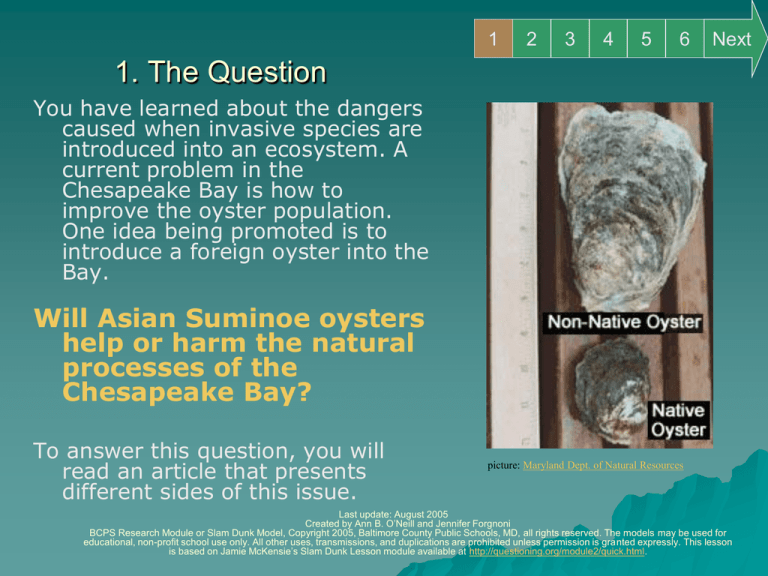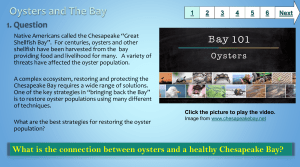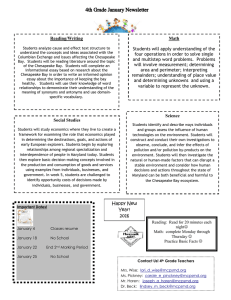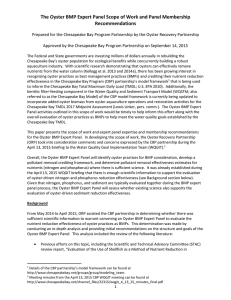
1
2
3
4
5
6
Next
1. The Question
You have learned about the dangers
caused when invasive species are
introduced into an ecosystem. A
current problem in the
Chesapeake Bay is how to
improve the oyster population.
One idea being promoted is to
introduce a foreign oyster into the
Bay.
Will Asian Suminoe oysters
help or harm the natural
processes of the
Chesapeake Bay?
To answer this question, you will
read an article that presents
different sides of this issue.
picture: Maryland Dept. of Natural Resources
Last update: August 2005
Created by Ann B. O’Neill and Jennifer Forgnoni
BCPS Research Module or Slam Dunk Model, Copyright 2005, Baltimore County Public Schools, MD, all rights reserved. The models may be used for
educational, non-profit school use only. All other uses, transmissions, and duplications are prohibited unless permission is granted expressly. This lesson
is based on Jamie McKensie’s Slam Dunk Lesson module available at http://questioning.org/module2/quick.html.
1
2
3
4
5
6
2. Information Sources
Read the article below in the online
magazine Infocus, published by
the National Academies. As you
read, use this glossary to help
you with words that may be new
to you. Also, after reading each
paragraph, stop and record
notes on the chart on the next
slide.
“From the Far East to
the Eastern Shore”
picture: Infocus magazine, with permission of
photographer Dave Hagan
Next
3. The Student Activity
Ways the Asian oyster
would be helpful:
Use this
chart to
record your
notes about
the Asian
oyster.
1
2
3
4
5
6
Next
Ways the Asian oyster
would be harmful:
1
2
3
4
5
6
Next
4. The Assessment Activity
After reading the article, decide if you STRONGLY AGREE, SOMEWHAT AGREE,
STRONGLY DISAGREE, or SOMEWHAT DISAGREE with the following statement:
Introduction of the Asian Suminoe oyster into the Chesapeake
Bay will be beneficial to both the seafood industry and to the
health of the Bay.
Your teacher will designate four areas of the room and you will join the group
in the area that shares your position (STRONGLY AGREE, SOMEWHAT AGREE,
STRONGLY DISAGREE, SOMEWHAT DISAGREE). As a group, discuss the issue,
decide on a position statement, and develop reasons to be presented to the
whole class to support that position.
Each group will present its viewpoint to the class. Students may ask questions
of one another. If you feel strongly influenced by another group’s presentation,
you may change corners.
Based on the presented material and your own views, write a reflection about
the ideas that influenced your position.
1
2
3
4
5
6
Next
5. Enrichment Activities
If you’d like to learn more about both
the Asian oyster and the American
oyster, here are some websites for you
to explore:
pictures:
Chesapeake Bay
Program
Eastern Oyster (Chesapeake Bay
Program)
Non-Native Oysters and the
Chesapeake Bay (Chesapeake
Bay Program)
1
2
3
4
5
6. Teacher Support Materials
Objective: Students will be able to utilize text and peer
debate in order to generate decisions about the
introduction of nonnative oysters into the Chesapeake
Bay.
Teacher Note: You may want to make copies in advance of
the chart on Slide 3 for student note-taking.
Differentiation: Provide copy of all text with information
needed for lesson highlighted.
Review glossary skills
Some of the Graphic Organizer may need to be
completed. (word box would assist students in
completion)
Allow students to rate with only agree or disagree.
Time Management Strategies: Two 45-minute class
periods are recommended—one for reading the article
and taking notes and one for the discussion activity.
AVID Strategy: Four-Corner Discussion
Learning Styles:
Field Dependent
•Visual
•Reflective
Field
Independent
•Analytical Understanding
Maryland Voluntary State Curriculum
Goal: 3.0 Life Science: Students will use scientific skills and
processes to explain the dynamic nature of living things, their
interactions, and the results from the interactions that occur over
time.
Ecology, Indicator: 1. Give reasons supporting the fact that
the number of organisms an environment can support
depends on the physical conditions and resources
available.
• b. Identify and describe factors that could limit
populations within any environment, such as
disease, introduction of nonnative species, depletion
of resources, etc.
enGauge
“As society changes, the skills needed to negotiate the complexities of
life also change…To achieve success in the 21st century, students
also need to attain proficiency
in science, technology, and culture, as well as gain a thorough
understanding of information in all its forms.”
(enGauge)
Digital-Age Literacy includes:
enGauge 21st Century Skills
6
Glossary
for article about Asian oysters
abundant
aquaculture
decimated
decline
desperation
displacing
dwindle
ecosystem
encounter
foe
irreversible
parasitic
plight
pest
radical
resistant
revive
rogue
sterile
thrive
more than enough; plentiful
the cultivation of fresh-water and salt-water plants and animals
destroyed or killed in large numbers
a gradual weakening; to fall or become less
a state of hopelessness leading to recklessness
removing from the usual or proper place
to make or become less
the whole group of living and nonliving things that make up an
environment and affect each other
come upon; meet unexpectedly or casually
enemy
impossible to reverse
of or relating to a plant or an animal that lives in or on some other
living thing and gets food and sometimes shelter from it
a usually bad condition or state
a plant or animal that is troublesome, annoying, or destructive
extreme; departing sharply from the usual or ordinary
able to fight against
to bring back or come back to life
an animal or plant that exhibits a a chance and usually inferior
biological variation
not able to produce offspring; not fertile
to grow very well; to flourish
Return to Slide 2: Information Sources






